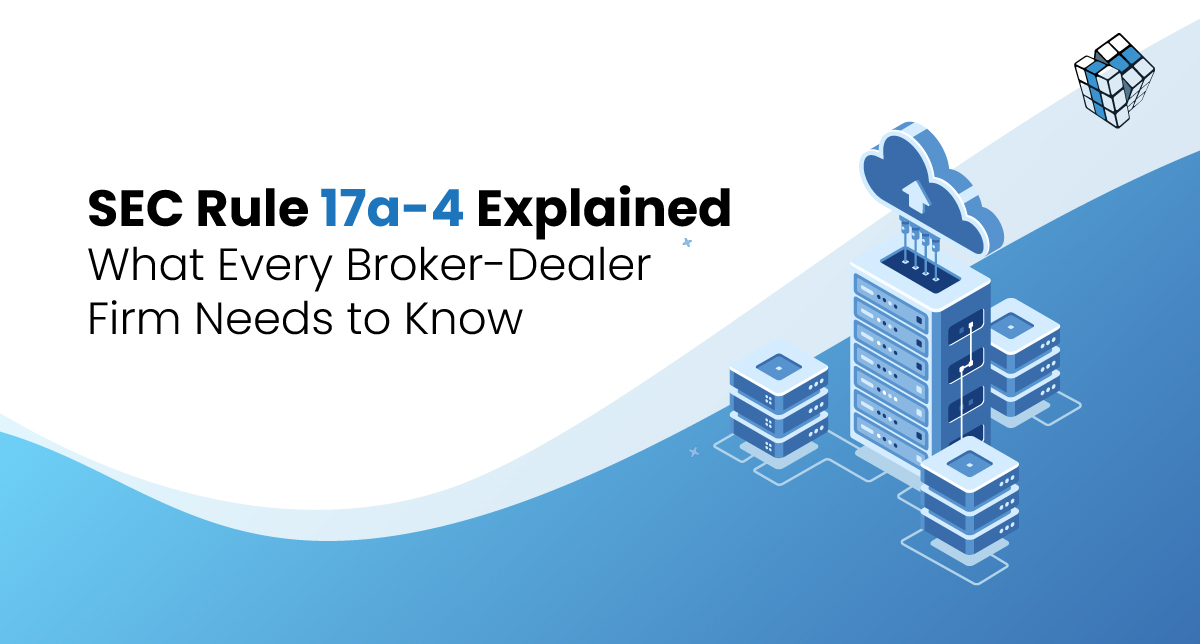
For broker-dealers, recordkeeping is not just administrative; it is regulatory risk management. The Securities and Exchange Commission (SEC) requires firms to create, preserve, and retrieve records that reflect the full scope of their securities business. Rule 17a-4 sets the preservation and storage standards that underpin this obligation. Getting it right is foundational to audits, dispute resolution, and the overall credibility of your compliance program.
In practice, 17a-4 touches operations, technology, legal, and compliance. It defines how records must be stored, how long they must be retained, and what controls must exist to ensure they cannot be altered. The firms that excel at this treat 17a-4 as a system, with governance, process, and technology working together, not a bolt-on repository.
SEC Rules 17a-3 and 17a-4: The Core Requirements
Think of Rules 17a-3 and 17a-4 as two sides of the same coin. Rule 17a-3 governs the creation of records: it requires broker-dealers to create comprehensive records for each securities transaction and for their securities business in general. This includes trade blotters, confirmations, customer account records, order tickets, communications, financial and operational records, and supervisory materials.
Rule 17a-4 governs the preservation of those records. It specifies what must be retained, for how long, in what form, and with what protections. It also establishes accessibility standards so that records are readily retrievable for regulators and internal reviews. Together, these rules ensure both the completeness and the integrity of the broker-dealer record lifecycle.
Storage Requirements: Non-Rewritable and Non-Erasable (WORM)
A cornerstone of Rule 17a-4 is that electronic records must be preserved in a manner that prevents overwriting, erasing, or otherwise altering them during the required retention period. This is commonly achieved through Write Once Read Many (WORM)-style controls. The goal is clear: once a record is stored, it must remain fixed and unchangeable through its full lifecycle.
Importantly, Rule 17a-4 does not require a particular technology or system to meet the non-rewriteable and non-erasable requirement. What matters is the outcome: the system must prevent alteration for the duration of the retention period.
Supervisory Requirements: Accountability, Auditability, and Approvals
Storage alone is not enough. The firm must implement a supervisory framework that provides clear visibility ensuring all records are securely stored in the WORM system. This begins with an audit ready system that captures who input what, when, and how, and continues with procedures that verify records are preserved for the correct length of time in a non-rewriteable and non-erasable manner.
Traditionally compliance teams do not have visibility into what is getting sorted and typical tech staff having access to storage lack compliance acumen leaving cracks and open risks. That is a clear recipe for disaster. In today’s regulatory environment firms need a clear process for oversight. That means easy to access, auditable storage setup.
Special Retention Circumstances: Legal Holds and Beyond
Regulatory retention periods are a baseline, not a ceiling. There are circumstances, such as litigation, investigations, or a subpoena, where a broker-dealer must maintain records beyond the standard retention schedule. In these cases, the firm must take appropriate steps to ensure that records are not deleted when the regulatory period ends but other legal obligations continue.
Practically, this means your storage platform must allow records to be retained beyond Commission-specified periods. You should be able to place targeted holds that supersede normal deletion schedules and keep detailed logs of when and why a hold was placed and who authorized it. Without this capability, the firm risks inadvertent spoliation and regulatory exposure.
Easily Accessible and Searchable: Don’t Overlook Retrieval
Rule 17a-4 expects that preserved records can be accessed efficiently. This extends beyond storage into indexing, classification, and retrieval design. If your system meets retention requirements but cannot locate and produce records within expected timelines, you will face examination challenges and operational friction.
A strong approach includes standardized metadata, consistent naming conventions, and robust search. Teams should be able to retrieve specific records within minutes, not hours, even as data volumes grow. This is where structure, governance, and user-friendly interfaces pay dividends.
Common SEC 17a-4 Pitfalls to Avoid
- Relying on legacy storage locking without proper oversight can create blind spots, especially when new data sources or formats are introduced.
- Inconsistent retention mappings may cause records to be stored for the wrong duration or in incorrect containers, increasing compliance risk.
- Absence of a formal legal hold process can lead to unintentional deletion of records needed for litigation or regulatory investigations.
- Lack of integration between incidents, reconciliations, and the storage platform prevents firms from identifying root causes and addressing them promptly.
Building a cohesive, end-to-end process that unifies these functions helps close control gaps and strengthens overall compliance oversight.
Meet 17a-4 with Confidence Using RSMS Vault
RSMS Vault, the latest regtech innovation from Capital Market Solutions, is purpose-built to address the full spectrum of compliance needs facing broker-dealers under Rules 17a-3 and 17a-4. More than a storage upgrade, RSMS Vault is a modern, secure, cloud-hosted SaaS platform designed around how compliance teams actually work. It unifies preservation, oversight, reconciliation, and reporting so firms can preserve records, retrieve them quickly, and demonstrate strong supervisory control.
RSMS Vault ensures WORM-style record locking and fully aligns with SEC Rule 17a-4 requirements, including supervisory control and support for special retention circumstances such as HOLD.
If your firm is ready to strengthen record preservation, enhance supervisory oversight, and simplify retrieval and reporting, RSMS Vault is built for you. Designed specifically to help broker-dealers meet SEC 17a-4 requirements with confidence, it delivers a comprehensive, scalable approach that goes beyond storage—offering the transparency, control, and peace of mind leadership teams need to manage risk effectively.
See RSMS Vault in action. Book a demo today and discover how modern compliance oversight should feel.
